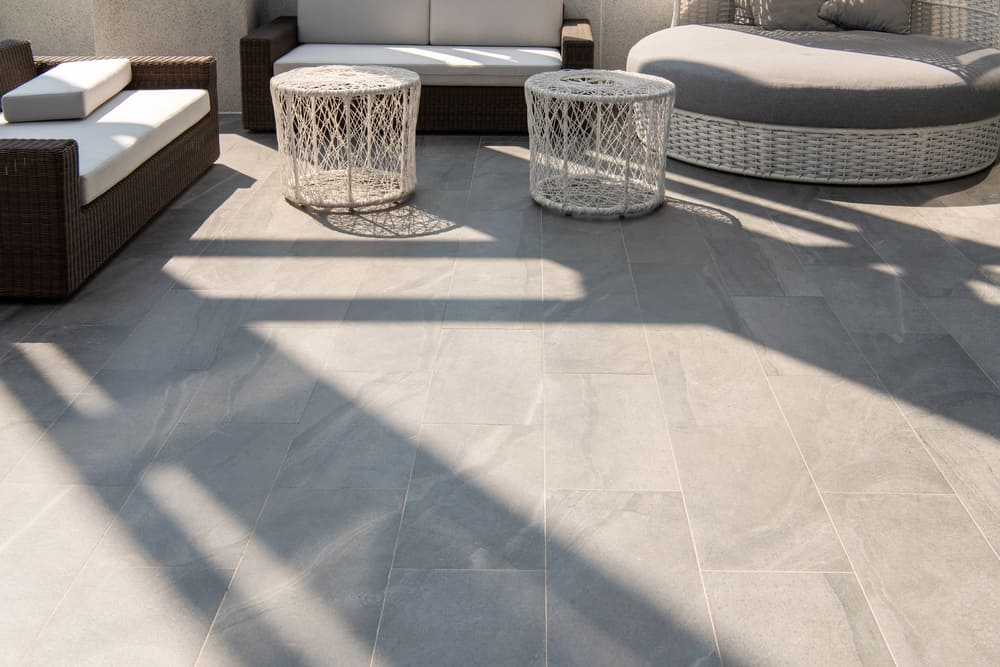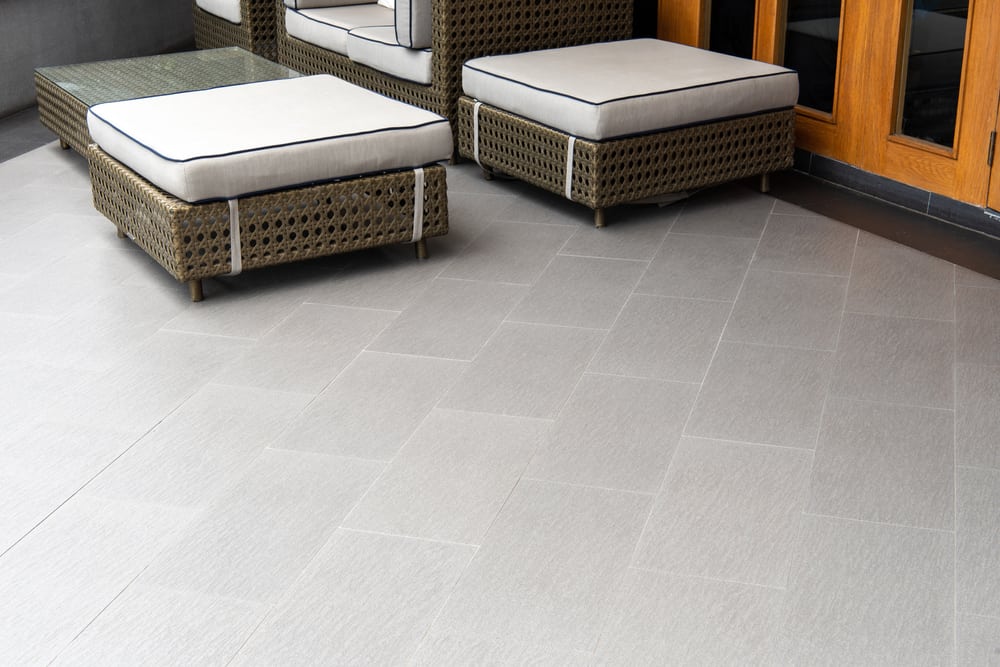I am excited to know that you are in the market for designing an outdoor patio. Your finished product will indeed become a special place in your home where you are sure to make so many wonderful family memories.
So, are you ready to choose a flooring surface for your outdoor patio? Vinyl is a beautiful flooring choice aesthetically and quite popular due to its durability and versatility. But is it suitable for your outdoor patio?
Because of its low-to-the-ground structure, we will find out that vinyl flooring may not be the most suitable option for your outdoor patio (unless it meets specific caveats).
Table of Contents
Decks, Porches, and Patios Discussed
Before worrying about flooring, be sure to select the most suitable outside space for your home. I advise you to consider your budget, location (weather limitations), available space, preferred size, and home design.
Due to its likeness in scope, people tend to confuse patios, decks, and porches; however, I am about to show you that these outdoor spaces have very distinct purposes and designs.
Decks
Decks are wooden structures usually built adjacent to your house, although they can be placed anywhere around your home. Many times they are made serving as a vantage point for a particular view.
You may choose to design a simple one-level or more complex multilevel deck to fit the amount of space you have available. Decks generally do not have a roof, but you may choose to add a cover or pergola for shade.
In addition, you may outfit your deck with a fire pit, hot tub, and outside furniture. The options are limitless, but you must remember to follow your local ordinances and adhere to building codes.
Porches
Having a porch added to your home is a great way to make your home feel more welcoming and hospitable. Think of the big wraparound porch that Noah promised Allie in the American romance drama, The Notebook.
A porch is usually an elevated open-air structure that is attached to your house. Its design should consider the architectural style of your home. Many porch styles up for consideration may range from an apartment-style stoop to a large veranda that extends multiple sides of your house.
One feature of a porch is that it provides a place to pause and relax before entering or leaving your home. So perhaps the most significant advantage of a porch is it will allow you and guests to enjoy the outside comfort of your home without worrying about the weather and other elements.
Patios
First, whereas a deck and a porch usually are elevated structures, a patio is almost always built at or near ground level.
Another distinction between a deck and porch from your outdoor patio is that you can attach it to your house, or you may choose to place and orient it with your landscape. That said, you can set your outside patio almost anywhere on your property, the backyard being the preferred option.
According to TNT Home Improvements, a patio offers people an outside area for people to “sit, eat, and relax.” In addition, you can adorn it with your choice of outdoor furnishings to include an outdoor kitchen.
An outdoor patio is quite versatile in both its design and the complementary features available. However, please note that installation professionals prefer the floor covering to be some form of hardscaping.
Fun in the Sun
In all three cases, consider these popular options to add outdoor living space to your house. So whether you choose to host social gatherings, have a family meal, or want a place to relax and watch the sunrise or sunset, the addition of one of these spaces will add personal value to your home for sure.
More on Patios
I assure you that an outdoor patio is worth everything you put into it. Whether you like simple and functional or have a fine-tuned taste for luxury appeal, there are some critical features of outdoor patios worth your consideration.
First, we look at the etymology of the word patio, followed by some thoughts about its placement within your available space. We will also consider covering your outdoor patio, and I will add a quick note on climate.
Before diving into the background and more precise definition of an outdoor patio, I recommend you consult local authorities for appropriate zoning laws and building codes before undertaking an outdoor project of this scope.
The etymology of the Word Patio?
Now, if you are a word buff like me, you will find pleasure in discovering the etymology of the word patio with me. Brittanica defines a patio as “a courtyard within a building, open to the sky.”
A patio can either be open to the sky, covered, or even enclosed. Please take note that a covered or enclosed patio will be subject to several building code regulations.
However, if you stay true to its Spanish architectural roots, an open-sky patio “is one of the least restricted construction projects around the home,” says remodeling expert Philip Schmidt.
Location, Location, Location
A patio can either be attached to your dwelling or featured as a separate landscape piece. Traditionally, homeowners construct patios in the back of their houses. Why?
An outdoor patio is commonly associated with dining and entertainment. Therefore, it would be helpful throughout the design process if you had a clear purpose for your outdoor patio in mind.
You could place the patio near the kitchen to expand your cooking and eating space. Or, you could attach it to your garage or office to extend your activity space or provide a place to kick back after a day behind the computer screen.
Likewise, your outside patio could have access from your living room to extend your entertainment area, especially if you like to host social gatherings.
If you have the available space and budget, your outdoor patio could even extend the back of your home with multiple access points.
Conversely, you have the freedom to set your outdoor patio in a specific area of your property to enjoy some shade. On the other hand, you may want it in a secluded spot for more privacy.
The ideas are endless, and you get to be the master designer when it comes to your relax place.
The Move to a Covered Patio?
In addition to having the freedom to choose the location of your patio, you may even decide to cover it. However, please know you will have to comply with more building restrictions if you go this route.
The International Residential Code (IRC) recognizes a patio cover to be a “structure with open or glazed walls that is used for recreational, outdoor living purposes associated with a dwelling unit.”
A roof must withstand a minimum live load of 10 pounds per square foot (PSF). If you add a cover, a significant advantage is that your flooring and furnishings will have some protection from the elements.
Furthermore, if you choose to enclose your outdoor patio, approved materials are limited to insect screening, translucent or transparent plastic, or glass conforming to specific provisions.
Climate: A Critical Element
Designing your outdoor patio requires you to consider the climate in your location. Although you can add waterproof comforts and furnishings for year-round enjoyment of your outside patio, the warmness and fantastic night breezes of the spring and summer months offer the best time to indulge casually.
I’m sure you want to build your outdoor patio to last. Who wouldn’t? Special care and maintenance will help increase its longevity; however, you must also select the most appropriate building materials.
So, now, let’s talk more about flooring.
Typical Flooring for Outside Patios
I noted earlier in American suburbia that homeowners usually pave their patio floors. Typically, patios come paved with concrete, bricks, tile, or some version thereof.
A patio sits upon a concrete slab or a sand and pebble base. Depending on the material, a patio will not require the same level of attention as a deck or porch. However, regular cleaning is critical, and some repairs may be necessary further down the road.
However, people’s satisfaction with the durability and versatility of vinyl has lent to an increasing demand to move this popular flooring option to the outdoors.
Is Vinyl Even an Option?
Although polyvinyl (the compound used to construct vinyl flooring) is ‘mostly waterproof,’ wear-resistant, and durable, it is not indestructible.
Lets us take a look at several variables that will weaken or even destroy your vinyl flooring.
- humidity
- extreme temperature (hot or cold)
- water leakage
- direct exposure to sunlight
- high-traffic
- heavy outdoor furniture
So, let us ponder vinyl’s suitability as a flooring option for your outdoor patio. Where do you live? Are you residing in coastal wetlands, rainy areas, dry and sunny areas, or in colder or warmer areas?
If exposed to any of the above elements, your vinyl flooring will be susceptible to cracking, mold, rot, swelling, bubbling, and all-out deterioration.
I think it would be a shame to throw away such a significant investment into your home. Do you agree?
But, if you insist on having vinyl flooring in your outside space, it may behoove you to reconsider your options and instead choose to design a deck or patio. If so, I recommend that you consult with a reputable waterproof deck manufacturer such as Tufdek, Econodek, Gfloor, or Duradek.
So Can You Use Vinyl on Your Patio?
The short answer is NO; however, if multiple caveats are in place, then the use of vinyl flooring has a little better chance of survival. Your outdoor patio will ideally:
- Be of a covered patio design to prevent direct sunlight exposure.
- Be attached to the slab of your house.
- Have proper drainage and grading to prevent standing water.
- Be raised to the upper limit of height restrictions.
- Have a temperature-controlled environment (enclosed options).
- Have a suitable subfloor and underlayment.
- Be of high-quality waterproof material.
These points are not in any way meant to detract from the many benefits of vinyl flooring. However, the pure design of a traditional outdoor patio does not support this flooring option as being a practical one. Therefore, even if you met the caveats above, you might still be at risk of significantly reducing the product life of your vinyl flooring.
Final Thoughts
Due to an outdoor patio’s typical design features and placement, you would be wise to consider something other than vinyl flooring. A hardscaping material is much better suited to withstand the elements.
Indeed, vinyl flooring comes highly rated as a residential and commercial flooring option, but remember that polyvinyl composite tends to suffer when exposed to several conditions such as sunlight and extreme temperature. Therefore, I advise you to stick with a more traditional patio flooring material, such as stone, brick, cement, or pebbles and leave vinyl flooring indoors.

